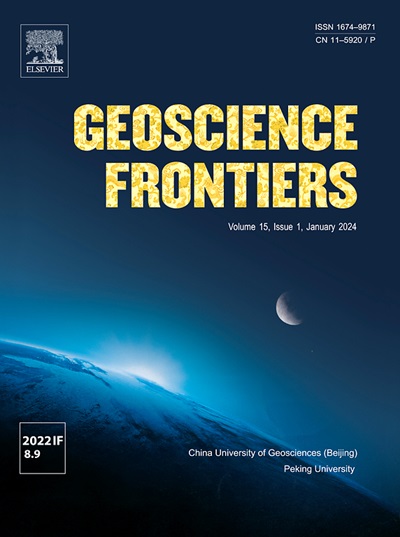Geological, structural, and temporal framework of hematite-rich IOCG mineralization at La Farola deposit in the Candelaria-Punta del Cobre district, Chile
IF 8.9
1区 地球科学
Q1 GEOSCIENCES, MULTIDISCIPLINARY
引用次数: 0
Abstract
Iron oxide-copper–gold (IOCG) deposits encompass a diverse set of mineralization styles, leading to outstanding questions about how different alteration facies are related across a single ore-producing system and the overarching mechanisms of ore genesis. This study investigates the age and characteristics of mineralization at the La Farola deposit, a hematite-dominated IOCG deposit located at the southern margin of the Candelaria-Punta del Cobre IOCG district of northern Chile. Two lithologically-controlled ore bodies occur along the WSW-ENE striking, ∼18° NNW-dipping contact between the Lower Cretaceous Chañarcillo Group and Punta del Cobre Formation. Syn-mineralization N-S to NNW-SSE striking sinistral strike-slip faults likely acted as fluid pathways. Distinct mineral assemblages include an early Na-Ca assemblage (albite-scapolite) overprinted by skarnoid garnet with minor pyroxene, Ca-Fe (magnetite-actinolite), and K-Fe (magnetite-k-feldspar-biotite and minor sulfides) assemblages. The main sulfide mineralization (chalcopyrite-pyrite with minor bornite) is associated with specular hematite-white mica-K-feldspar-calcite and overprints all previous assemblages. The presence of hematite as the dominant Fe-oxide phase associated with Cu mineralization is characteristic of lower-temperature IOCG deposits, and may be a result of La Farola’s stratigraphic position <700 m higher than other deposits in the district. New U-Pb ages of 115.7 ± 1.2 Ma for garnet and Re-Os ages of ∼113–114 Ma for sulfides indicate mineralization occurred within a 3-million-year timeframe. These findings confirm hematite-dominant mineralization at La Farola was coeval with IOCG mineralization across the district. This research contributes to understanding IOCG systems and their formation mechanisms, highlighting the control local geological structures and alteration processes has on the diversity of mineralization types associated with a single IOCG system.

智利Candelaria-Punta del Cobre地区La Farola矿床富赤铁矿的地质、构造和时间格架
氧化铁-铜-金(IOCG)矿床包含多种矿化风格,这就导致了一个悬而未决的问题,即不同的蚀变相是如何在一个单一的成矿系统中联系起来的,以及矿石形成的总体机制。本文研究了位于智利北部Candelaria-Punta del Cobre IOCG区南缘以赤铁矿为主的La Farola矿床的成矿年龄和特征。两个岩性控制的矿体产于下白垩统Chañarcillo群与Punta del Cobre组之间沿WSW-ENE走向、~ 18°nnw倾斜接触方向。同矿化N-S至NNW-SSE走向的左旋走滑断裂可能是流体通道。不同的矿物组合包括早期的Na-Ca组合(钠长石-角长石),上面覆有少量辉石、Ca-Fe(磁铁矿-放光石)和K-Fe(磁铁矿-钾长石-黑云母和少量硫化物)组合。主要的硫化物成矿(黄铜矿-黄铁矿,少量斑铜矿)与镜面赤铁矿-白云母-钾长石-方解石组合有关,并覆盖了所有先前的组合。赤铁矿作为主要的铁氧化物相,与铜成矿有关,是低温IOCG矿床的特征,可能是La Farola的地层位置比该区其他矿床高700 m的结果。石榴石的新U-Pb年龄为115.7±1.2 Ma,硫化物的Re-Os年龄为~ 113-114 Ma,表明成矿作用发生在300万年的时间框架内。这些发现证实了La Farola以赤铁矿为主的成矿作用与整个地区的IOCG成矿作用是一致的。该研究有助于理解IOCG系统及其形成机制,突出了局部地质构造和蚀变过程对单一IOCG系统相关矿化类型多样性的控制作用。
本文章由计算机程序翻译,如有差异,请以英文原文为准。
求助全文
约1分钟内获得全文
求助全文
来源期刊

Geoscience frontiers
Earth and Planetary Sciences-General Earth and Planetary Sciences
CiteScore
17.80
自引率
3.40%
发文量
147
审稿时长
35 days
期刊介绍:
Geoscience Frontiers (GSF) is the Journal of China University of Geosciences (Beijing) and Peking University. It publishes peer-reviewed research articles and reviews in interdisciplinary fields of Earth and Planetary Sciences. GSF covers various research areas including petrology and geochemistry, lithospheric architecture and mantle dynamics, global tectonics, economic geology and fuel exploration, geophysics, stratigraphy and paleontology, environmental and engineering geology, astrogeology, and the nexus of resources-energy-emissions-climate under Sustainable Development Goals. The journal aims to bridge innovative, provocative, and challenging concepts and models in these fields, providing insights on correlations and evolution.
 求助内容:
求助内容: 应助结果提醒方式:
应助结果提醒方式:


